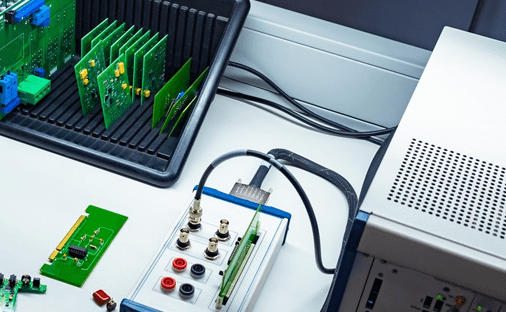The electrical test (E-Test) for circuit boards is performed after manufacture. Your
circuit boards are checked with a flying probe, or for larger series using an adapter
E-Test.
The layout is analysed according to the net list (from the Gerber data) for short
circuits and interruptions.
This is enormously important, because only the E-test detects incorrect and broken
conductors. Without E-test the usability of your PCB is only a game of luck!
The detected defective circuit board is rejected or marked within the panel.

Electrical Test Terminology
100% Net List Test: Check of every “node” on
every net on the board.
Adjacency Test: Type of test for checking
isolation between conductors – shorts test. A software generated program that checks for
nets that are within a tolerance set by the user. Two methods are used – Proximity Adjacency
and Line of Site Adjacency.
Clam Shell Test: Provides simultaneous testing
of both sides of the board at the same time. These types of fixtures are used on single grid
testers and dual grid testers. A very reliable method of bare board testing because all
points are tested at the same time.
Combined Grid/Probe Testing: Using the flying
probe test sequence to cover areas of the board with fine pitch, high density points while
the grid test verifies power to ground separation, through hole and wider pitch component
pads.
Comparative or Golden Board Test: Method using
a “master” or known good board (KGB) to learn a program and then test other boards against
the learned net list program. Poor choice for test accuracy – you may be learning a “bad”
board.
Continuity Test: Verification that the
resistance between test points is lower than the specified limit or maximum continuity
resistance. See shorts and opens tests.
End of Net: A feature which is either the
origin or the termination of a conductor network.
Endpoint: A test point or node required to be
tested to meet the 100% continuity and isolation test.
Field Effect and Field Measurement Test: Refer
to a type of test that uses large nets as antennas to send a specific high frequency
alternating current at a specific voltage. The remaining nets are checked and those that
have similar voltages for all antennas are considered as shorted and then retested using
Ohm’s law resistance to verify the shorts.
Flip Test: Consists of two separate,
independent single sided tests on a universal grid. Testing one side and then the other.
Unless a significant number of points are tested during both tests it can be a very
inaccurate method.
High Pot Test: Refers to high voltage potential
testing to check for high resistance continuity or leakage between ground and power planes.
DC voltages in the 500 to 1000 volt ranges are used for a specified dwell time.
Impedance: The design of a circuit and the
frequency of the current passing through it have various affects on the alternating current
passing through it. The combination of these effects and the resistance of the conductor is
called impedance.
Impedance Control Test: A device called a TDR
(Time Domain Reflectometer) is used to check circuits to determine if they are within
expected tolerances. Conductor length, spacing, width, height and separation affect the
impedance.
In Circuit Test: Test performed after
components are installed – a check for shorts or opens caused during assembly operations.
Isolated Land: A test point not connected to
any other test point or net. Also called a single point net, singlet or no connect.
Isolation Resistance: The resistance tolerance
between the circuit board’s non-connected traces and/or lands.
Land: A portion of a conductive pattern usually
used for connection, component attachment or both. Surface mount pads, component hole pads,
gold fingers etc.
Leakage: Movement of current between two
conductors that are not connected and therefore should be isolated by a minimum amount of
resistance. Causes significant “noise” in the properties of the circuit board.
Mid Net Point: A feature which is a not at
either the termination or origin of an interconnecting network
Net: An entire string of points or connections
from the first source point to the last target point including lands and vias.
Net List: A list of alpha-numeric locations,
used to describe a group of two or more points that are electrically common
Node: A connection point between a network and
an off- the-board item like a component or test probe. See Land
Opens Test: Check to make sure there is current
flow from one “node” to the next for every net on the board, again by measuring the amount
of resistance of the conductor.
Optimized Net List Test: Check every “end of
net” for all nets on the board and selected intermediate nodes on the board.
Shorts Test: Check to make sure that NO current
flows between separate nets by measuring the amount resistance between them.
